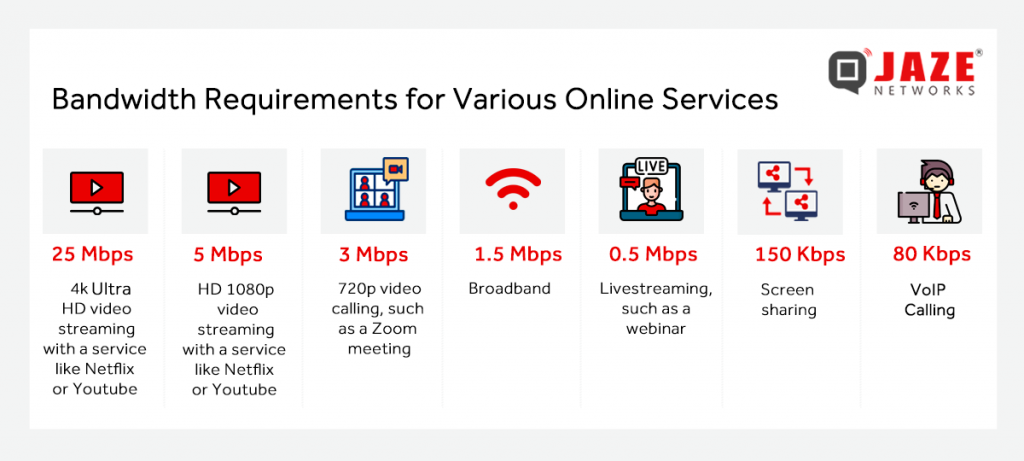Network Bandwidth: The Data Highway
Network bandwidth refers to the maximum amount of data that can travel across a network connection in a given amount of time. It’s essentially the capacity of your internet pipe. The wider the pipe (higher bandwidth), the more data can flow through it, resulting in a faster and more efficient connection.
Bandwidth vs. Speed:
Many people confuse bandwidth with internet speed.Bandwidth is the capacity of the connection, whereas speed is how fast the data actually travels. Think of it like this: if bandwidth is the width of the highway, speed is how fast cars (data) are moving. A high-bandwidth connection allows more cars to travel at once, but the speed at which they move depends on various factors, such as network congestion and hardware capabilities.

Importance of Bandwidth
Bandwidth is crucial because it directly impacts the efficiency and performance of your network activities. In other words, it keeps your connection flowing smoothly. Higher bandwidth allows for:
- Streaming high-definition videos: Video streaming services require a lot of data transfer. Without sufficient bandwidth, you might experience buffering and lag.
- Downloading large files: Large files like games or software downloads take longer with lower bandwidth.
- Supporting multiple devices: With more devices connected to your network (phones, laptops, tablets), bandwidth is shared. Higher bandwidth ensures a smooth experience for everyone.
How Fast is Your Internet Connection?
Traditionally, bandwidth was measured in bits per second (bps). However, with today’s high-speed connections, we more commonly use Mbps (megabits per second) or Gbps (gigabits per second) to represent bandwidth. There are two main types of bandwidth connections:
- Symmetrical: Symmetrical connections have equal data capacities for both uploading and downloading.This is often seen in enterprise-grade internet connections.
- Asymmetrical: Asymmetrical connections, on the other hand, have different upload and download capacities, with upload speeds typically being slower. This is more common in home internet plans.
Understanding Bandwidth Calculations:
Technology: Newer technologies like fibre optics with multiplexing can squeeze more data through a connection compared to older copper options.
Spectrum Licensing: In mobile networks (LTE, 5G), operators have licensed spectrums for data transmission, offering a more controlled environment.
Wi-Fi Spectrum: Wi-Fi uses unlicensed spectrum, so multiple access points competing for the same frequencies can lead to bandwidth congestion.
Effective Bandwidth : The highest reliable transmission rate a link can provide is measured by a bandwidth test, which involves repeatedly timing the download of a specific file from origin to destination.
Calculating Bandwidth Needs
- Identify Applications: Determine which applications will be in use.
- Application Requirements: Assess the bandwidth requirements for each application.
- Multiply by Users: Multiply each application’s bandwidth requirements by the number of expected simultaneous users.
- Sum Total Bandwidth: Add together the bandwidth requirements for all applications.
Bandwidth for Clouds and WAN Links
- Local vs. Wide Area Networks: Bandwidth on local area networks (LANs) is usually much higher than on WAN or DIA connections.
- Monitor Utilisation: Track bandwidth usage over different periods (daily, weekly, monthly, yearly) to ensure the network link has sufficient bandwidth and determine if an upgrade is necessary.
Factors Affecting Network Performance
Even with high bandwidth, other factors can impact your experience:
- Data Delivery: Lost data packets (packet loss) and delays (latency) hinder efficient data transmission. Additionally, fluctuations in packet arrival times (jitter) can disrupt smooth data flow.
- Bottlenecks: Network paths often involve multiple connections with varying capacities. The connection with the lowest bandwidth can bottleneck the entire network, limiting overall performance.
- Aggregated Links: Enterprise networks may use multiple connections combined into a single, logical link (aggregated link). While this increases total capacity, failure of even a single connection can reduce overall bandwidth.
The demand for bandwidth is expected to increase significantly in the coming years with the emergence of new technologies such as VR and AR. Additionally, IoT and AI will further drive the need for higher bandwidth.
Currently, a household with multiple streaming devices and users typically requires about 50 Mbps. However, this requirement is expected to rise dramatically. In response, some broadband providers have already started offering 1 Gbps plans to their subscribers.
To meet the future’s increased throughput demands, broadband providers need scalable BRAS routers.
Jaze ISP Manager integrates with all leading hardware and software BNG providers. It supports both RADIUS and Diameter protocols, offering unlimited scalability for service providers. Click here for more details.






